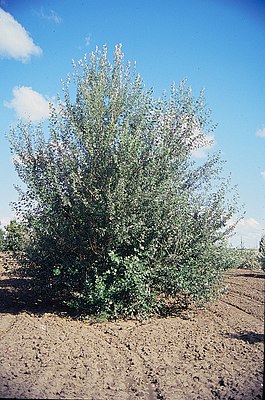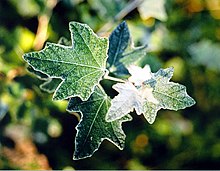Silver poplar
| Silver poplar | ||||||||||||
|---|---|---|---|---|---|---|---|---|---|---|---|---|

Silver poplar ( Populus alba ) |
||||||||||||
| Systematics | ||||||||||||
|
||||||||||||
| Scientific name | ||||||||||||
| Populus alba | ||||||||||||
| L. |
The silver poplar or white poplar ( Populus alba ) is a plant from the genus of poplars in the family of the pasture plants (Salicaceae).
description
Habitus
The silver poplar is a deciduous, straight-growing deciduous tree that, depending on its location, can reach heights of 15 to 45 meters. While the average chest height diameter that can be achieved is rarely more than 2 m, trees with a trunk diameter of 1.5 to 3 meters have also been found in Hungary . The 500-year-old silver poplar near Boudky , which fell over in 1904 , reached a height of 36 meters, a trunk diameter of 3.52 meters and a trunk circumference of 11.25 meters.
At the base of the straight or slightly curved trunk there are often saplings and water veins . The silver poplar is one of the shallow roots. Their roots are far reaching. The silver poplar usually forms a characteristic broad, rounded and loosely branched crown , which often overhangs to one side and gives the tree an asymmetrical appearance. The crown of younger trees has a rather oval to conical shape. The silver poplar can reach an age of around 300 to 400 years.
bark
The bark initially shows a white-gray color and a smooth structure with large, diamond-shaped cork warts. With increasing age, the bark takes on a dark gray color and forms deep longitudinal furrows. The youngest branches, like the green shoots, usually have white felted hairs. If you cut a branch of the breadth on, we see the five-edged Mark .
leaf
The alternate leaves of the silver poplar are rich in shape and divided into a petiole and a leaf blade. The flat and hairy petiole is 2 to 5 inches long. The simple leaf blade has no glands at the base of the stalk. Maple-like, often three- to five-part, lobed and roughly toothed leaves are formed on long shoots , which can reach a length of up to 12 centimeters and a width of up to 10 centimeters. Your underside of the leaf has a mostly permanent white felt hair.
On the lower part of long shoots as well as on short shoots , ovoid to rounded, unlobed leaves develop with a length of 4 to 7 centimeters and a width between 3 and 4 centimeters. The leaf margin shows irregular, wavy teeth, the underside of the leaf a rather gray-felted, usually permanent hair. Both leaf types develop downy hairs on their dark green and shiny upper surface in the early stages, which, however, are lost in the course of further growth. The oval, light brown buds are also hairy white felt. In autumn you can admire the yellow color of the silver poplar leaves.
Inflorescence and flower
The silver poplar is dioeciously gendered ( diocesan ). This means that there are either male or female kittens on a tree. The flowering period extends from March to April and is before the leaves shoot. The cat- shaped inflorescences hang limply. The kittens usually reach a length of 4 centimeters. The green-blooded female kittens stretch up to 10 cm during the fruiting process. Each of the inconspicuous individual flowers sits in the axilla of an inverted lanceolate, irregularly short-toothed and ciliate bract . The female flowers have a bald, conical and short-stalked ovary . The two yellow-green scars are divided into four linear lobes almost to the base. The reddish to yellowish blooming male flowers form eight to ten carmine-red stamens per flower .
Chromosome number
The number of chromosomes is 2n = 38 or 57.
ecology
The silver poplar is pollinated by the wind. The spread of the diaspores , the very small seeds with a basal head of hair, is done by the wind. The seeds ripen from May to June in a small capsule in the hanging fruit cluster. The short-lived seeds have no storage tissue. Since the silver poplar forms abundant root shoots , it is also possible for it to spread itself .
Although the silver poplar is wind flowering, bees collect the abundant pollen from the male kitten flowers.
The silver poplar is used as a forage plant by caterpillars of various butterfly species. The caterpillar of the white poplar kahneulchen ( Earias vernana ) is considered endangered according to the red list and, as a monophage user of the silver poplar, is existentially dependent on it. The poplar hawk ( Laothoe populi ) feeds oligophagous on the young shoots and shoots of the silver poplar, while the willow-headed owl ( Parastichtis ypsillon ) prefers to eat shoot tips and younger leaves. The caterpillars of the brown ribbon wool-backed moth ( Tethea or ) live spun between the leaves of the tree. The Zackeneule ( Scoliopteryx libatrix ), also a oligophager user eats preferably at the shoot tips, the Hornet Moth ( Sesia apiformis ) is found mostly on individually or in small groups standing trees. The caterpillars of the evening peacock ( Smerinthus ocellata ), the yellow-brown autumn owl ( Agrochola macilenta ) and the caterpillars of the small grouse ( Clostera pigra ) living between spun leaves have been identified as polyphagous users of the silver poplar . The caterpillars of the blackberry moth ( Macrothylacia rubi ), the gold afer ( Euproctis chrysorrhoea ) and the zigzag toothed moth ( Notodonta ziczac ), which is mainly found on young growth, also feed polyphagously on the silver poplar .
Occurrence
The natural distribution area extends over central, southern and eastern Europe, western Siberia , western Asia and northern Africa . In Central Europe their population density is given as scattered. They are found particularly in the area of larger rivers, such as the Danube, Upper Rhine and Oder regions. It is considered naturalized in Western and Northern Europe and parts of Central Europe.
As an ornamental tree, the silver poplar is also planted beyond the natural occurrence, where it then grows wild. As a useful tree, the silver poplar has been largely displaced by hybrid breeding in the past few decades, despite a low rotation time of only 50 to 60 years.
The relatively drought - resistant semi-light and pioneer tree species is a shallow root and prefers moist, fresh, loose, nutrient-rich and alkaline soils with gravelly loam and clay in the subsoil all year round . It likes to colonize light alluvial forests in large river plains, such as those on the Elbe, Danube or Rhine. They are found particularly frequently under river-accompanying trees in the hardwood floodplain, an alluvial forest characterized by irregular flooding. The silver poplar can also colonize dry alluvial soil like a shrub. On peat soils , they can be equally as thrive on dry and poor sandy soils. It is a regularly encountered species in coastal pioneer forests. Locations directly on the coast dominate crooked shrub forms. Both summer heat and winter cold are tolerated by the silver poplar. The silver poplar is a character species of the association oak-elm forest, hardwood floodplain ( Querco-Ulmetum ) from the association of alder-ash floodplain forests ( Alno-Ulmion ).
The name of the tree was already used in the Middle Ages for the former Viennese suburb and today's district of Albern near the Danube.
use
The fast-growing silver poplar is of biological engineering importance due to its modesty and abundant root brood in the area of the dune reinforcement . Gardening and landscaping appreciate them as an avenue tree and a popular green in parks. The soft wood of the silver poplar is characterized by a wide sapwood and yellow-brown core . It is used to make paper, wood wool and wood fiber boards.
More pictures
swell
- Gregor Aas , Andreas Ruedmller: Deciduous trees , Gräfe & Unzer Verlag.
- Werner Rothmaler : Excursion flora from Germany - vascular plants: Basic volume 2 , spectrum academic publishing house, ISBN 3-8274-1359-1 .
- Gerhard Stinglwagner , Ilse Haseder , Reinhold Erlbeck: Das Kosmos Wald- und Forstlexikon , Kosmos-Verlag, ISBN 978-3-440-10375-3 .
- Populus alba L., silver poplar. In: FloraWeb.de.
Individual evidence
- ↑ L. Dimitri: Encyclopedia of Woody Plants - 24th Erg.Lfg. 6/01
- ↑ Archived copy ( memento of the original from June 21, 2013 in the Internet Archive ) Info: The archive link was inserted automatically and has not yet been checked. Please check the original and archive link according to the instructions and then remove this notice.
- ↑ Archived copy ( memento of the original from June 21, 2013 in the Internet Archive ) Info: The archive link was inserted automatically and has not yet been checked. Please check the original and archive link according to the instructions and then remove this notice.
- ^ A b Rothmaler: Exkursionsflora von Deutschland , Spektrum Akademischer Verlag Heidelberg, Berlin, 20th edition 2011, ISBN 978-3-8274-1606-3 , p. 350.
- ↑ a b Eckehart J. Jäger (Ed.): Exkursionsflora von Deutschland. Vascular plants: baseline . Founded by Werner Rothmaler. 20th, revised and expanded edition. Spektrum Akademischer Verlag, Heidelberg 2011, ISBN 978-3-8274-1606-3 , p. 301 .
- ↑ Steinbach's great plant guide, Ulmer Verlag, ISBN 978-3-8001-7567-3 , p. 452 f.
Web links
- Silver poplar . In: BiolFlor, the database of biological-ecological characteristics of the flora of Germany.
- Profile and distribution map for Bavaria . In: Botanical Information Hub of Bavaria .
- Populus alba L. In: Info Flora , the national data and information center for Swiss flora . Retrieved October 2, 2015.
- Thomas Meyer: Data sheet with identification key and photos at Flora-de: Flora von Deutschland (old name of the website: Flowers in Swabia ).











